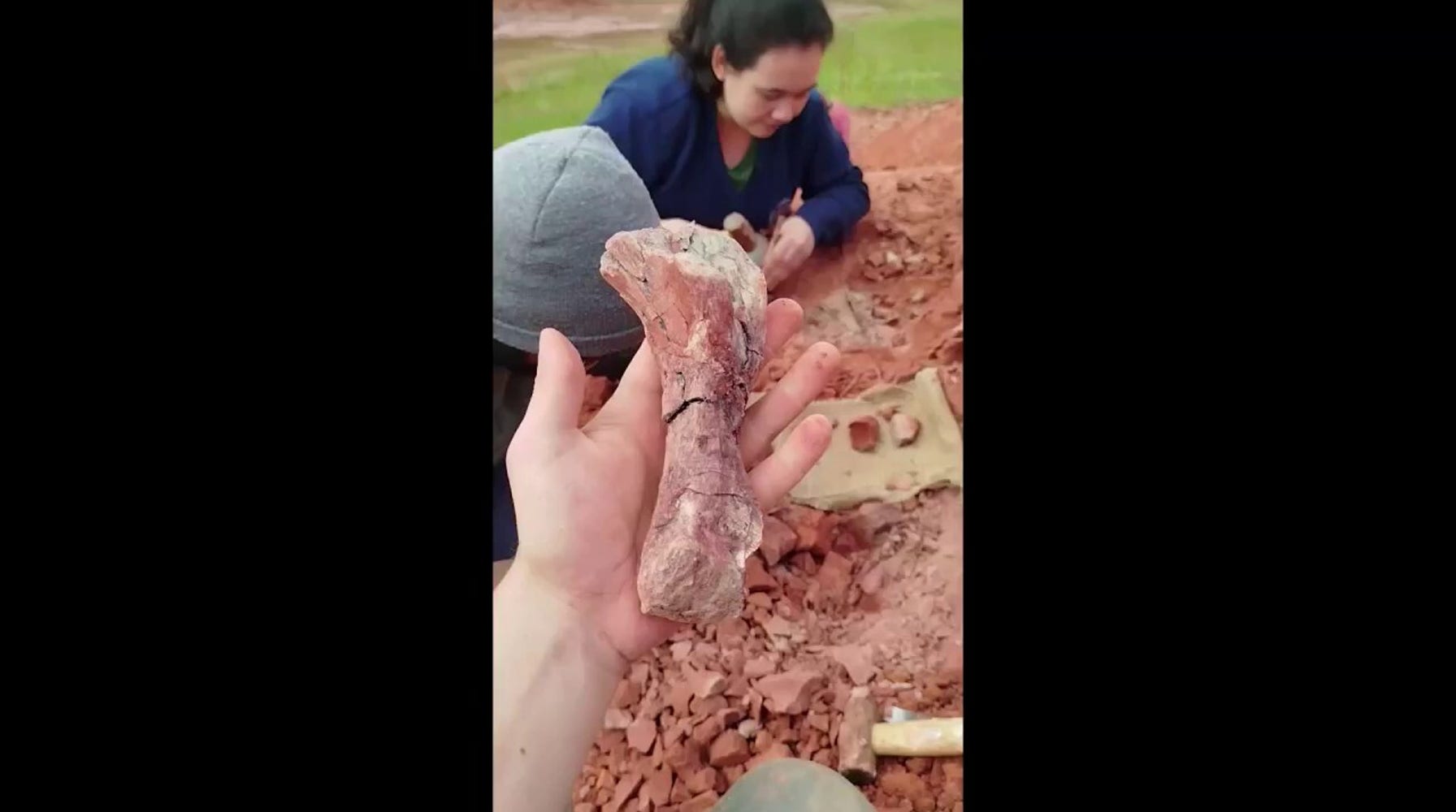Unearthing Ancient Giants: Rare Dinosaur Skeletons Emerge from Catastrophic Flooding
- August 25, 2024 09:03pm
- 394
Paleontologists have made an extraordinary discovery in Brazil, where catastrophic flooding has revealed the fossilized remains of dinosaurs that roamed the Earth millions of years ago. The bones, estimated to be 233 million years old, provide valuable insights into the diversity and evolution of these prehistoric creatures.
The relentless forces of nature have unearthed a treasure trove of ancient history in Brazil, as paleontologists have uncovered dinosaur skeletons following catastrophic flooding in the region. These fossils, believed to be 233 million years old, offer a glimpse into a time when colossal creatures roamed the Earth.

Unearthing Ancient Giants: Rare Dinosaur Skeletons Emerge from Catastrophic Flooding
The latest discovery adds to a growing body of evidence that sheds light on the evolution and diversity of dinosaurs. In Kyrgyzstan, an expedition team of German and Kyrgyz researchers has uncovered the remains of a new species and genus of theropod dinosaur, named Alpkarakush kyrgyzicus. This carnivore, which lived approximately 165 million years ago, is the first theropod dinosaur found in Kyrgyzstan and represents a significant find in Central Asia.
Alpkarakush kyrgyzicus was a formidable predator, with an estimated length of around 30 feet. Its distinctive features include a protruding "eyebrow" on its postorbital bone, indicating the presence of a horn, as well as unique characteristics in its dorsal vertebrae and femur.

Unearthing Ancient Giants: Rare Dinosaur Skeletons Emerge from Catastrophic Flooding
The discovery of Alpkarakush kyrgyzicus fills a significant gap in our knowledge of Jurassic theropods, providing new insights into their evolution and biogeography. Professor Oliver Rauhut of the Bavarian Collection of Paleontology and Geology, a lead author of the study published in the Zoological Journal of the Linnean Society, emphasizes the importance of this find in unveiling the complexities of these ancient creatures.
Alpkarakush kyrgyzicus and Tyrannosaurus rex (T. rex) were both theropods, though they lived in different eras and regions. Theropods, characterized by their strong back legs and shorter front limbs, gave rise to modern-day birds.

Unearthing Ancient Giants: Rare Dinosaur Skeletons Emerge from Catastrophic Flooding
The discovery of a juvenile Alpkarakush kyrgyzicus specimen alongside the adult raises questions about parental care in these dinosaurs. The naming of Alpkarakush kyrgyzicus pays homage to Kyrgyz mythology and the location of its discovery, honoring the legendary bird that aids heroes in times of need.
These fossil discoveries serve as tangible reminders of the astonishing diversity of life that existed on our planet millions of years ago. They provide invaluable information for scientists seeking to understand the evolution and behavior of these prehistoric behemoths.

Unearthing Ancient Giants: Rare Dinosaur Skeletons Emerge from Catastrophic Flooding
As we continue to unravel the secrets of the past, these dinosaur skeletons serve as a testament to the incredible power of time and the resilience of life itself. They remind us that our world has undergone countless transformations, and that the wonders of the past will forever inspire future generations.
Related articles
-
 Unearthing the Mysteries of Sanxingdui: A Treasure Trove of Ancient Wonders
The Sanxingdui Ruins in China have yielded an extraordinary collection of artifacts that provide glimpses into an enigmatic ancient civilization....
Unearthing the Mysteries of Sanxingdui: A Treasure Trove of Ancient Wonders
The Sanxingdui Ruins in China have yielded an extraordinary collection of artifacts that provide glimpses into an enigmatic ancient civilization....
- 05 Oct 2024
-
 Biden's Stance on Israel's Response to Iran Draws Criticism from Republicans
President Biden's assertion that Israel's response to Iran's missile attack should be "proportional" has been met with disapproval from some...
Biden's Stance on Israel's Response to Iran Draws Criticism from Republicans
President Biden's assertion that Israel's response to Iran's missile attack should be "proportional" has been met with disapproval from some...
- 05 Oct 2024
-
 Fox News First: 'Trio of Crises' Hinder Harris-Walz Campaign
Fox News Sunday's Shannon Bream examines how concerns over the White House's response to Hurricane Helene, the Israel conflict, and the port strike...
Fox News First: 'Trio of Crises' Hinder Harris-Walz Campaign
Fox News Sunday's Shannon Bream examines how concerns over the White House's response to Hurricane Helene, the Israel conflict, and the port strike...
- 05 Oct 2024
-
 Belfast Woman Faces Assault Charges After Allegedly Attacking Good Samaritans Who Tried to Free Captured Baby Seagull
A Belfast woman is facing assault charges after she allegedly attacked good Samaritans who attempted to free a baby seagull she had captured. Angela...
Belfast Woman Faces Assault Charges After Allegedly Attacking Good Samaritans Who Tried to Free Captured Baby Seagull
A Belfast woman is facing assault charges after she allegedly attacked good Samaritans who attempted to free a baby seagull she had captured. Angela...
- 05 Oct 2024
-
 Wayfair's Fall Way Day Sale: Get Your Home Ready for the Holidays with Unbelievable Deals
Get ready for Wayfair's Fall Way Day sale from October 5th to 7th, featuring over one million items on discount and site-wide free shipping. Take...
Wayfair's Fall Way Day Sale: Get Your Home Ready for the Holidays with Unbelievable Deals
Get ready for Wayfair's Fall Way Day sale from October 5th to 7th, featuring over one million items on discount and site-wide free shipping. Take...
- 05 Oct 2024
-
 Israel's Effort to Dismantle Hezbollah: Analysis by Gen. Jack Keane
Gen. Jack Keane, Fox News senior strategic analyst, analyzes Israel's ongoing operation against Hezbollah in Lebanon, highlighting the threat posed...
Israel's Effort to Dismantle Hezbollah: Analysis by Gen. Jack Keane
Gen. Jack Keane, Fox News senior strategic analyst, analyzes Israel's ongoing operation against Hezbollah in Lebanon, highlighting the threat posed...
- 05 Oct 2024

Leave a comment
Your comment is awaiting moderation. We save your draft here
0 Comments
Chưa có bình luận nào